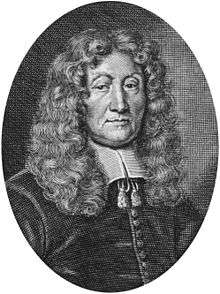William Walwyn

William Walwyn (bap. 1600–1681) was an English pamphleteer, a Leveller and a medical practitioner.[1][2]
Walwyn was a silkman in London who took the parliamentary side in the English Civil War. He advocated religious toleration and emerged as a leader of the Levellers in 1647 which led to his imprisonment in 1649. During 1646 he wrote five pamphlets in response to Thomas Edwards' Gangraena in which Walwyn was described as "a Seeker, a dangerous man, a strong head". In 1649, whilst held in the Tower of London on a charge of Treason, he published "The Fountain of Slaunder Discovered" and "Walwyns Just Defence" to defend his character against the publication of "Walwyn's Wiles".[3][4] The pamphlet had seven authors who were the leading Baptist and Independent preachers in London at the time Arnald, Burnet, Foster, Kiffin, Lordall, Price, and Rosier, but was mainly drafted by John Price who had previously attack Walwyn in print after four of the Leveller petitions were burnt by the common hangman in June 1647 (see "Gold Tried in the Fire"). In Price's opinion it was Walwyn not Lilburne who was the most dangerous of the Leveller leaders.[5] In 1653 when Lilburne was arrested having returned from exile in Bruges, Overton and Prince rallied support, Walwyn however was arrested and held in the tower until after Lilburne's trial was concluded.[6]
Walwyn's Wiles
This pamphlet was written by seven of the leading London Independent and Baptist preachers and published whilst Walwyn and the other Leveller leaders were held in the tower. The full title was "Walwyn's Wiles, or the Manifestators manifested, ... declaring the subtle and crafy wiles, the atheistical, blasphemous soul-murdering principles and practices of Mr William Walwyn". Walwyn's Wiles was a response to the jointly signed Leveller pamphlet "A Manifestation" (April 14, 1649) which whilst it denied that they intended to level men's estates also stood firm on the principles outlined in The Agreement of the People.
In the ten pages of Wiles Walwyn is variously described as a Jesuit, a bigamist, of having persuaded a woman to commit suicide, and that he would "destroy all government", that he had said "that it would never be well until all things were common", and that he had also said that there would be "no need for judges ... take any other tradesman that is an honest and just man and let him hear the case".
In response Walwyn published two pamphlets "The Fountain of Slaunder Discovered" in which he defended his morality, and which had written a year before but held back from publication. The second pamphlet was a direct response to Wiles as its full title "Walwyns Just Defence against the Aspertions Cast upon him, in a Late Un-Christian Pamphlet Entitled, Walwyns Wiles" makes clear. The Just Defence contains a great deal of detail of the Leveller movement and the Independents from 1646 onwards.
Works
Political and Religious Writing
- A New Petition of the Papists 1641
- Some Considerations Tending to the Undeceiving Those, Whose Judgements Are Misinformed 1642
- The Power of Love 1643
- The Compassionate Samaritane 1644
- Good Counsell to All 1644
- A Help to the Right Understanding of a Discourse Concerning Independency 1644/5
- Englands Lamentable Slaverie 1645
- Tolleration Justified and Persecution Condemned 1645/6
- A Whisper in the Eare of Mr. Thomas Edwards, Minister 1645/6
- A Word More to Mr Thomas Edwards ... Concerning the National Covenant 1645/6
- A Word in Season: To All Sorts of Well Minded People 1646
- An Antidote against Master Edwards 1646
- The Just Man in Bonds 1646
- A Remonstrance of many Thousand Citizens (a collaboration with Richard Overton) 1646
- A Prediction of Mr Edwards His Conversion and Recantation 1646
- A Demurre to the Bill for Preventing the Growth and Spreading of Heresie 1646
- A Parable, or Consultation of Physitians upon Master Edwards 1646
- A Still and Soft Voice from the Scripture 1647
- Gold Tried in the Fire; or, The Burnt Petitions Revived 1647
- The Bloody Project 1648
- The Vanitie of the Present Churches 1648/9
- A Manifestation (jointly signed) 1649
- An Agreement of the Free People of England (jointly signed) 1649
- The Fountain of Slaunder Discovered 1649
- Walwyns Just Defence 1649
- Juries Justified 1651
- W Walwyns Conceptions; For a Free Trade 1652
Medical Writing
- Spirits Moderated 1654
- Healths New Store-House Opened 1661
- A Touch-Stone for Physick 1667
- A Physick for Families 1669
References
- ↑ David Plant, William Walwyn, Leveller, c.1600–81 , British Civil Wars & Commonwealth website, Retrieved 8 July 2009
- ↑ Barbara Taft, "Walwyn, William (bap. 1600, d. 1681)", Oxford Dictionary of National Biography, Oxford University Press, Sept 2004; online edn, Oct 2008 accessed 8 July 2009
- ↑ Lee, Sidney (1903), Dictionary of National Biography Index and Epitome, p. 1364 (also main entry lix 284)
- ↑ Walwym is sometimes confused with William Walwyn who was appointed canon of St. Paul's, London, in 1660, but is not the same man. (Lee, Dictionary of National Biography Index and Epitome (1903))
- ↑ William Walwyn; Jack R. McMichael; Barbara Taft (1989). The Writings of William Walwyn. University of Georgia Press. ISBN 978-0-8203-1017-6. Retrieved 23 July 2012.
- ↑ Henry Noël Brailsford (1961). The Levellers and the English Revolution. Stanford University Press. p. 616. ISBN 978-0-8047-0095-5. Retrieved 23 July 2012.
- Attribution
![]() This article incorporates text from a publication now in the public domain: Lee, Sidney, ed. (1903). "Walwyn, William". Dictionary of National Biography. Index and Epitome. Cambridge University Press. p. 1364.
This article incorporates text from a publication now in the public domain: Lee, Sidney, ed. (1903). "Walwyn, William". Dictionary of National Biography. Index and Epitome. Cambridge University Press. p. 1364.
External links
- (French) Presentation of Walwyn on Wikibéral